
The Pound to US Dollar exchange rate (GBP/USD) slid by around -0.8 cents to 1.5630 last night as traders appeared reluctant to hold Sterling positions above the key technical resistance level of 1.5700.
In terms of data releases, the economic calendar looked to favour the Pound as UK CPI rose to 2.7% and US inflation lagged behind at 1.4%. British Consumer Prices are forecast to carry on growing, peaking just above 3.0% later on in the year, which is likely to cause a headache for incoming Bank of England Governor Mark Carney and his ambitions to ease the UK economy out of its post-crisis slump. However, the sticky CPI rate should benefit the Pound as it safeguards Sterling from further devaluation in the form of quantitative easing.
On the contrast, the soft US CPI print offers little incentive for the Federal Reserve to slowdown its expansive asset purchasing programme as the US Central Bank has previously stated that QE3 will continue until the Unemployment Rate falls to 6.5% or the Consumer Price Index rises to 2.5%.
However, with speculation growing on both sides of the ‘will they, won’t they’ tapering debate, investors took the Sterling / US Dollar exchange rate lower yesterday in case the Central Bank springs a surprise on markets and opts to dramatically decrease the size of its quantitative easing scheme.
The most likely scenario is that Fed Chairman Ben Bernanke will give some forward guidance, hinting at a future tapering of asset purchases, but will not actually reduce the pace of its $85 billion a month scheme at this juncture. Under this scenario, the recent hawkish rhetoric from the Fed would have to be put down as a ‘testing of the water’, aimed at breaking the illusion of infinite cheap money. With markets growing punch-drunk on stimulus, the Fed is running the risk of creating another bubble, this time in equity markets, and for this reason the decision to wean traders off QE3 slowly is a wise one.
Fed slowdown could have a substantial effect on the US Dollar
However, there is every possibility that the Fed will, in fact, announce a slowdown of its asset purchasing programme later on today and this could have substantial effect on the US Dollar. Quantitative easing is seen to devalue the ‘Greenback’ by artificially reducing the yield on US Treasuries, which in turn diminishes the appeal of the US currency to speculative traders. Naturally, a QE slowdown would allow US Treasury yields to rise and therefore improve the profit available to traders; subsequently increasing demand for the US Dollar.
Whilst the US Dollar would be expected to post gains across the board if the Fed does announce a slowdown of asset purchases, the Pound would also stand to benefit against the majority of its, riskier, currency counterparts. Sterling has the potential to rally against the Euro, the Canadian Dollar, the Australian Dollar and the New Zealand Dollar if Ben Bernanke lives up to the hype and cools down the Fed’s monetary easing scheme.
Also on the agenda, is the latest Bank of England Minutes report, which is likely to be overlooked at the expense of the more influential Central Bank statement from the Federal Reserve.

Comments are closed.